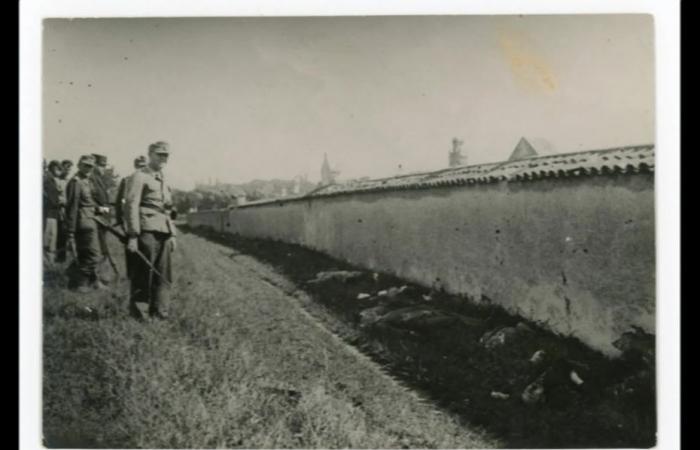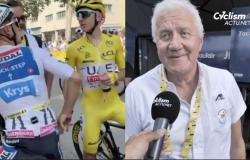
On June 29, 1944, seven Jewish hostages were shot in Rillieux-la-Pape, near Lyon. A massacre recognized as a crime against humanity for which Paul Touvier, head of the militia’s intelligence service, was sentenced to life imprisonment. A tribute will be paid to them on Sunday June 30
It is still very early on the morning of June 29, 1944 in Rillieux-La-Pape, then a commune in Ain. Many residents are awakened by the sound of gunfire.
The first witnesses discovered seven corpses. Seven victims shot in the back with machine guns by the Lyon militia, then shot in the head. All are Jewish.
The day before, Philippe Henriot, secretary of state for propaganda of the Vichy regime, was shot dead by resistance fighters in Paris. It was therefore an act of reprisal decided, in the hours that followed, by Paul Touvier, head of the intelligence service of the Lyon militia. He had arrests made in the street, at their homes.
Léon Glaser is a lawyer, Emile Zeizic a merchant, Maurice Schlisselmann a leatherworker, Claude Ben Zimra a decorator. And then again: Louis Krzyzkowski, Siegfried Prock and an unknown person “looking 25 years old”, never identified.
They join other prisoners in a militia cell, Impasse Catelin in Lyon. But it is these seven who, demanded by the Germans, will be designated by Paul Touvier to be executed.
Nicole Zeizic, Emile’s granddaughter, describes the circumstances in which this notable from Sainte Foy-les-Lyon was arrested by the militia: “The militiamen, who I think were four in number, burst in. It was the family meal. They arrested my grandfather in front of my grandmother, who wanted to give him her overcoat so that he wouldn’t leave like that. But the militiamen told my grandmother: ‘where he’s going, he won’t need it.’ In Lyon, even if the Jews did not wear the yellow star, they had been registered. And my grandfather, as a good French republican, had gone to have his identity card stamped with the word ‘Jew’. And this against the advice of the police officers who had received him and who had tried to send him home. My father, who was in his thirties, was more aware of the danger and had had false papers made and had taken shelter in the countryside. And his tragedy was not having managed to convince his parents to do the same.”
For historian Stéphane Nivet, this tragedy is both a desire for revenge by the militia and an expression of the anti-Semitism of this paramilitary group, particularly Paul Touvier.
“Philippe Henriot was assassinated in his ministry in Paris by resistance fighters disguised as militiamen. It is obvious that the militia wanted to avenge this almost narcissistic injury for them, having seen the head of propaganda, a militiaman himself, being murdered by people who were wearing their uniform and there is the desire to immediately attack Jews.
“Even if they do not wear the yellow star, the situation tightened in the former free zone in 43 and 44 around the repression of the Jews. The specificity of what is going to take place in Lyon is that we have a conjunction with the presence of the Gestapo of Klaus Barbie and the militia. It is a paramilitary organization of Vichy which serves as an auxiliary in the pursuit of Jews and resistance fighters but particularly Jews. And Paul Touvier never hid his anti-Semitism and his trial showed it in 1994.”
For years, Paul Touvier escaped justice, thanks in particular to the complicity of fundamentalist Catholic circles. He even pretended to be dead. He was finally arrested at the Saint Joseph priory in Nice in May 1989.
On April 20, 1994, after 5.5 hours of deliberation, the Versailles Assize Court sentenced Paul Touvier to life imprisonment for complicity in crimes against humanity. He is the first to be convicted of this crime. He died of cancer in detention two years later.
As every year, the memory of this massacre will be perpetuated this Sunday, June 30 in the morning, undoubtedly with a little more emotion than usual.
The Rillieux la Pape massacre memorial commemorating the assassination of 7 Jewish hostages by the militia, at the place where they were shot on June 29, 1944 along the cemetery wall.
•
© France 3 Rhône-Alpes
On Rue du Souvenir Français – formerly Rue du Cimetière – there is a memorial along the cemetery wall, at the very spot where the seven hostages were murdered.
The commemorative plaque was vandalized shortly after Paul Touvier’s conviction. The names of Léon Glaser, Emile Zeizic and Maurice Schlisselmann are engraved in the marble of their tombs.
For Nicole, Emile Zeizic’s granddaughter, who only learned very late the true circumstances of her grandfather’s death: “I am keen to pass on this memory and I think that in these times, it is better not to forget the past.”





